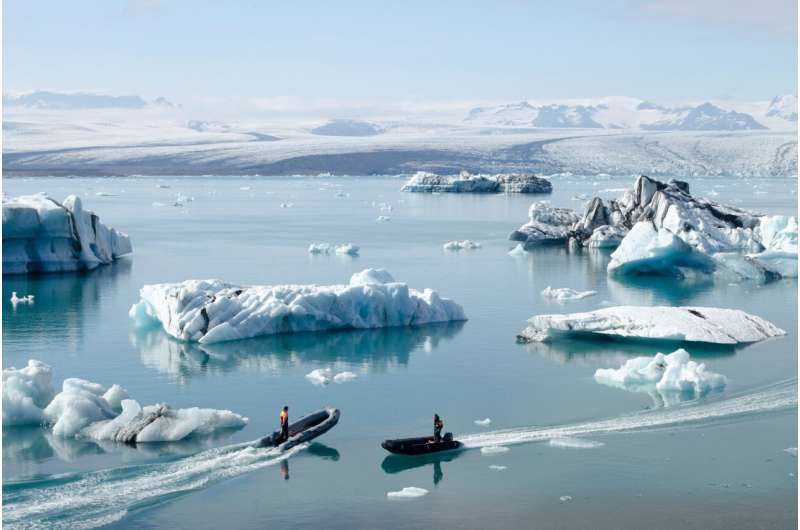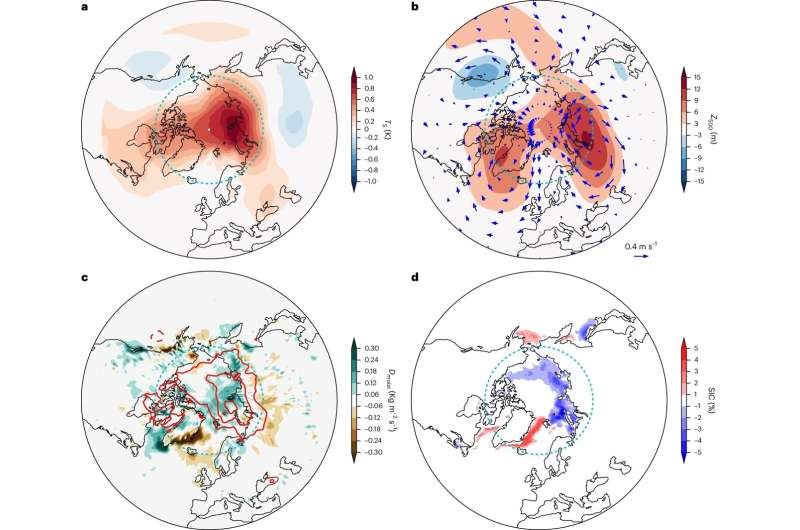June 12, 2024 feature
This article has been reviewed according to Science X's editorial process and policies. Editors have highlighted the following attributes while ensuring the content's credibility:
fact-checked
peer-reviewed publication
trusted source
proofread
Study finds Arctic warming three-fold compared to global patterns

Global warming is an omnipresent issue, with widespread initiatives to draw down emissions and mitigate against the International Panel on Climate Change's worse-case scenario predictions of 3.2°C of warming by 2100 (relative to pre-Industrial levels). Current measurements stand at 1.1°C of warming across Earth, but polar regions are experiencing enhanced surface warming compared to the rest of the planet.
Quantifying this amplification of warming in the Arctic (>65°N) compared to global means, and the mechanisms behind this, is the subject of new research published in Nature Geoscience.
Dr. Wenyu Zhou, of the Pacific Northwest National Laboratory, U.S., and colleagues investigated previous reports of Arctic amplification factors of two to four since 1979, and determined a factor of three to be more likely based upon Earth's natural variability modulating temperature change.
"Natural variability is like noise," Dr. Zhou explains. "Even in the absence of external forcing (such as changes in greenhouse gases), the state of the climate system can fluctuate due to its coupled dynamics of ocean, atmosphere and land. Such variability can occur at various timescales (interannual, decadal, multi-decadal) depending on the corresponding 'mode.'
"Thus, the observed Arctic amplification consists of two parts—the part that is forced by external forcing and the part due to natural variability (which leads to the temporal anomaly in the degree of Arctic amplification).
"The alarming fourfold Arctic amplification in recent decades challenges our previous beliefs and is rarely reproduced by climate models," Dr. Zhou says.
"It remains elusive whether this discrepancy reflects a temporary anomaly due to natural variability or a forced state of Arctic warming systematically underestimated by models."
To explore this, the research team compared observational data to model simulations, finding the difference in amplification factor between the two could be explained by natural variability, specifically certain ocean and climate patterns associated with the region. This includes the Interdecadal Pacific Oscillation and Arctic internal mode.

The Interdecadal Pacific Oscillation is a 20- to 30-year pattern of climate and oceanographic change across both hemispheres of the Pacific Ocean where positive phases see warming to the east and cooling to the west, swapping during negative phases.
The negative phase is most important as it links to a higher frequency of La Niña events (trade winds push warm water towards Asia resulting in the upwelling of cool, nutrient-rich water along the American coastline, often increasing the severity of hurricane season here), and has been found to have had a reductive effect on Arctic warming since 2000.
Meanwhile, the Arctic internal mode is determined to have enhanced warming since 2005. This relates to positive phases resulting in warming over the Kara Sea, with anti-cyclonic climate patterns bringing moisture to the area that encourages longwave radiation to be absorbed and warm the surface, leading to melting of sea ice.
A strong decline in sea ice results in ice-albedo feedbacks that lead to further warming. This process occurs due to melting sea ice reducing the amount of 'white' reflective surface for incoming solar radiation, instead increasing the surface area of comparatively 'dark' ocean to absorb radiation, therefore warming the ambient environment and causing further melting of sea ice that continues a runaway feedback loop.
Overall, across the study periods of 1970–2004 and 1980–2014, Arctic amplification was determined to be 2.09 and 3.98 respectively from observational data, changing to 2.28 and 3.33 with the removal of the Interdecadal Pacific Oscillation, and then 2.85 and 2.94 after additionally removing the effect of Arctic internal mode.
Consequently, a consistent amplification factor of three is identified, which matches that used in Coupled Model Intercomparison Projects (CMIP6), supporting its reliability for predicting future climate change.
"Here, we provide clear evidence to show that the fourfold Arctic amplification previously reported is an anomaly caused by dominant modes of natural variability and the degree of forced amplification is consistently around three throughout the historical period."
This research is important as it highlights the sensitivity of modeling climate change and the conclusions drawn to predict future patterns of global warming. Accounting for natural variability and identifying an amplification factor of three instead of four means future mitigation strategies may not have to be so severe in the decades to come.
Indeed, Dr. Zhou and colleagues suggest that the Arctic internal mode is likely to shift to a negative phase and Interdecadal Pacific Oscillation to a positive one in the coming decades, which would lead to a reduction in the Arctic amplification factor, perhaps even as low as two.
More information: Wenyu Zhou et al, Steady threefold Arctic amplification of externally forced warming masked by natural variability, Nature Geoscience (2024). DOI: 10.1038/s41561-024-01441-1
Journal information: Nature Geoscience
© 2024 Science X Network



















